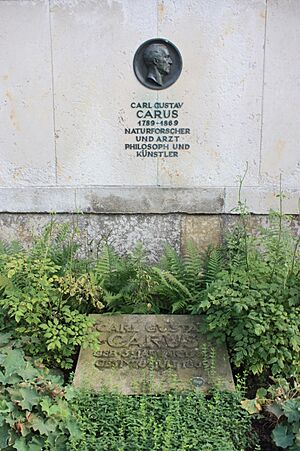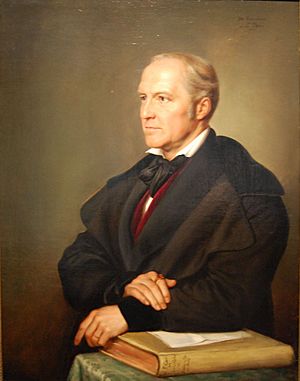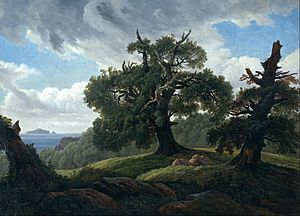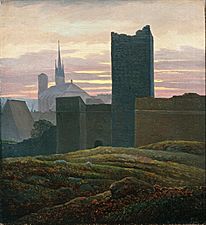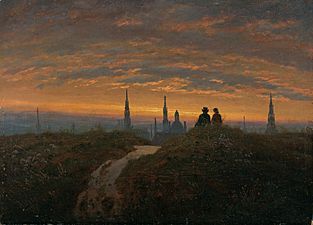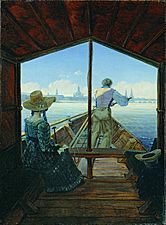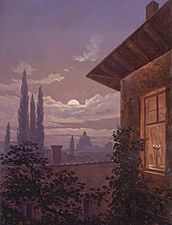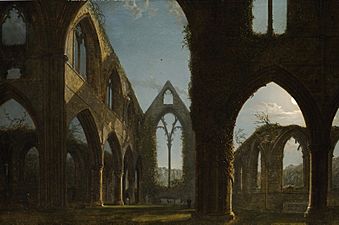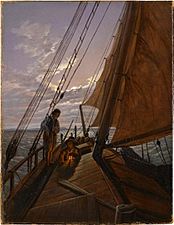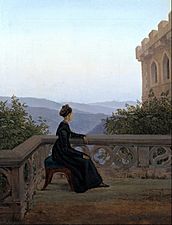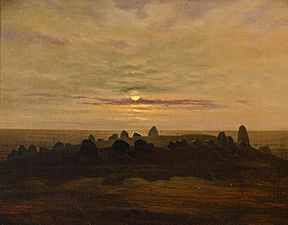Carl Gustav Carus facts for kids
Quick facts for kids
Carl Gustav Carus
|
|
|---|---|

Portrait by Johann Carl Rößler
|
|
| Born | 3 January 1789 |
| Died | 28 July 1869 (aged 80) |
| Known for | Painting |
Carl Gustav Carus (born January 3, 1789 – died July 28, 1869) was a talented German physiologist (a scientist who studies how living things work) and a painter. He was born in Leipzig and was an important figure during the Romantic era.
Carus was a very versatile person. He was a doctor, a naturalist (someone who studies nature), a scientist, a psychologist (someone who studies the mind), and a landscape painter. He even learned painting from the famous artist Caspar David Friedrich. He was also a friend of the well-known writer Johann Wolfgang von Goethe.
Contents
Life and Amazing Work
Carl Gustav Carus became a doctor of medicine and philosophy in 1811. This means he was highly educated in both science and deep thinking. In 1814, he became a professor of obstetrics (which is about childbirth) in Dresden. He also directed a maternity clinic there.
Besides his medical career, Carus taught himself oil painting. From 1814 to 1817, he learned from Caspar David Friedrich, a famous landscape painter in Dresden. Later, he also studied at the Oeser drawing academy.
Traveling with a King
In 1844, Carus had a special adventure. He traveled with Frederick Augustus II of Saxony, who was the King of Saxony. They went on an informal trip to Britain. It wasn't an official state visit, but the King and Carus were guests of Queen Victoria and Prince Albert at Windsor Castle.
This trip allowed Carus to see many famous places in London. He also visited the old university cities of Oxford and Cambridge. He even met other scientists who were making new discoveries. They explored many parts of England, Wales, and Scotland. After the trip, Carus wrote a book about his journey called The King of Saxony's Journey through England and Scotland, 1844.
Ideas About Life and the Mind
Scientists know Carus for an important idea called the vertebrate archetype. This was a very early and important idea that helped Charles Darwin develop his theory of evolution. In 1836, Carus was chosen as a foreign member of the Royal Swedish Academy of Sciences, which is a big honor for a scientist.
Carus also wrote a famous book called Psyche in 1846. In this book, he explored the idea of the unconscious mind. This is the part of our mind that works without us even knowing it.
The famous psychologist Carl Jung later praised Carus for highlighting the unconscious mind. Jung said that Carus was one of the first to truly see the unconscious as a key part of our mind.
Carus also had a unique theory about landscape painting. He believed that paintings should show the "inner workings" of the Earth. He called this "Erdlebenbildkunst," which means "pictorial art of the life of the earth."
Carl Gustav Carus passed away in Dresden. He is buried in the Trinitatis-Friedhof (Trinitatis Cemetery) in the city.
Family Life
Carl Gustav Carus had a daughter named Charlotte Carus. She married another artist, Ernst Rietschel.
Written Works and Ideas
Carl Gustav Carus wrote many books and papers on a wide range of topics. He was truly a person with many interests!
- Science and Nature: He wrote about zoology (the study of animals), entomology (the study of insects), and how different animals are built (comparative anatomy). He also explored ideas about how life develops. Some of his works include Textbook of Zootomy and About the Blood Circulation of Insects.
- Medicine: As a doctor, he wrote important medical books. These covered topics like gynecology (women's health) and the human body's systems (physiology).
- Mind and Philosophy: Carus was very interested in the human mind. He wrote Lectures on Psychology and his famous book Psyche; on the Developmental History of the Soul. He also explored ideas about different hand shapes and human abilities.
- Art: He shared his thoughts on painting, especially landscape painting. His book Nine Letters on Landscape Painting is well-known.
- Travel: He published his travel experiences, like his journey through England and Scotland, and a book about Sicily and Naples.
He even translated parts of Dante Alighieri's famous poem, Divine Comedy, into German.
Art Gallery
-
The Colosseum in Moonlight
-
Balcony Room with a View of the Bay of Naples , 1829 or 1830.
See also
 In Spanish: Carl Gustav Carus para niños
In Spanish: Carl Gustav Carus para niños
- Philosophy of the Unconscious (a book by Eduard von Hartmann, influenced by Carus)
- List of German painters



